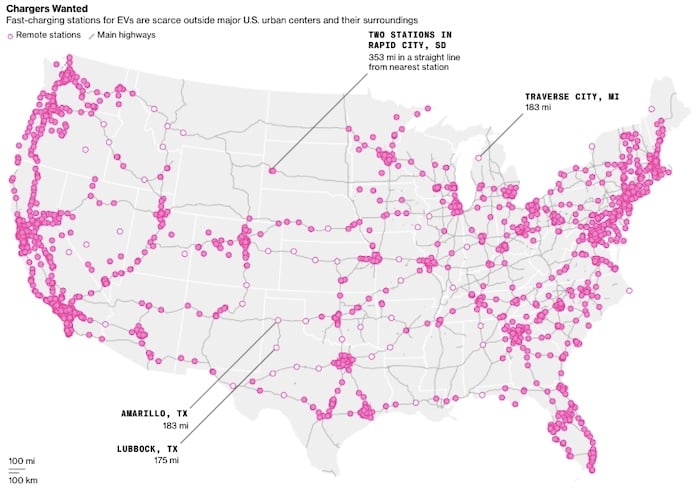The Main Problem With Widespread EV Adoption? “Charging Deserts”
Many drivers are reticent to invest in electric vehicles because of the scarcity of charging stations. But some companies are getting creative with urban charging methods.
There are three major obstacles to electric vehicle adoption: high price, low driving range, and a dearth of chargers. And while technological advances have remedied these three challenges in some ways, there is another important factor—city structure—that is essential for efficient charging infrastructure. As New York Times journalist Lawrence Ulrich describes, one major roadblock to mainstream EV adoption is the "charging desert" in big cities.

Map of fast-charging EV stations in the U.S., which are especially scarce outside of cities. Image used courtesy of Bloomberg
In this article, we’ll look at the effect of city structure on charging solutions and two companies hoping to workaround urban EV charging shortages.
How City Structure Affects Charging Solutions
Compare the infrastructure of a city like Los Angeles, where many people live in homes, with Manhattan and its high-rise multi-unit apartments.
People in LA with EVs (who do not usually exceed their battery range on a given day) can easily charge their vehicles from their garages for about 8–12 hours at night. Such a long charging time allows drivers to use a low-power (and consequently, low-cost) charger. In fact, a home charger can cost as little as $500, according to a McKinsey & Company report on EV infrastructure.
Another advantage of home charging is that residential electricity is cheaper than commercial electricity in many countries. Besides, the electricity price is further reduced during off-peak hours of the night.
But charging wouldn't be quite as simple for the typical EV driver in Manhattan, requiring the driver to either find an apartment complex with charging ports or use fast public chargers. It's important to note, too, that fast public chargers are significantly more expensive than home chargers, costing anywhere from $25,000 to $200,000 depending on the power level.
Unlike the primarily home-based EV charging infrastructure in Los Angeles, cities with many high-rise apartments rely on public chargers, which are few and far between.
Two Possible Solutions for Urban EV Charging
While the shortage of EV chargers, especially in large cities, won't be solved overnight, several companies are changing the structural designs of EV charging stations to accommodate street-side and parking lot charging stations—a possible solution for adding these hubs to crowded city infrastructures.
Urban Electric’s Pop-up Chargers
One interesting solution comes from the British EV charging start-up Urban Electric Networks Ltd. The company has been installing and testing its on-street pop-up charging hubs for some time now. These pop-up chargers deliver 7 kW at each socket and can be useful for those who have to park their cars on the street at night.

Urban Electric pop-up charging hubs. Image used courtesy of Urban Electric
An interesting feature of these chargers is that when the charger is not used, it automatically retracts underground to avoid a clutter of chargers on the street.
Volkswagen’s Charging Robot
Another effective charging solution for urban areas is proposed by Volkswagen. A quick video of the concept released by the company introduces a mobile charging robot that can communicate with the electric cars in a parking garage and automatically charge them if required.

Rendering of Volkswagen's self-driving robot that charges EVs in parking garages. Screenshot used courtesy of Volkswagen
The charging system consists of a self-driving robot and some energy storage devices that are carried by the robot. The energy storage devices are actually 25-kWh battery packs. The system is a DC fast charger and can charge a vehicle at 50 kW.
Conclusion
While a lack of efficient charging infrastructure could become a major roadblock in EV uptake, charging solutions such as the pop-up charging hubs and the Volkswagen’s charging robot can be effective solutions in cities where many people live in multi-unit high-rise apartments.
Until city planners make significant changes to downtown infrastructures—namely, with widespread charging ports—it's possible that technologies like the retractable hub and the charging robot will continue to crop up.
To see a complete list of my articles, please visit this page.
Do you work with EV charging technology? What challenges do you see with widespread implementation? Share your experiences in the comments below.







